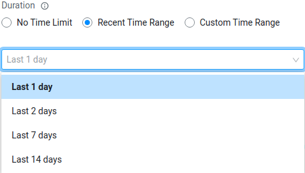Options for generating the CDP Private Cloud diagnostic data
You can specify various options on the Collect and Send Diagnostic Data pop-up window to generate CDP Private Cloud diagnostic data based on your specific requirements of duration, scope, and size.
Duration
Select the duration for which you want to generate the diagnostic data.
You can select from the following options:
- No Time Limit: Select this value if you want all the diagnostic data to be generated from the time you deployed CDP Private Cloud.
- Recent Time Range: Select a specified time range, in
hours, from the drop-down list.

- Custom Time Range: Select the start date and end date
between which you want to generate the diagnostic data.

Scope
Select the services for which you want to collect the diagnostic data.
You can select environment- and workload-related options from the following:
- All Environments and Control Plane: Select this option to
generate the diagnostic data for all the environments and workloads deployed on
CDP Private Cloud.

- Environment: Select one or more environments from the drop-down list to generate the diagnostic data. You can also use regular expressions to filter the name of environments for which you want to generate the diagnostic data.
- Custom: You can filter your selections to specific
environments and workloads, and accordingly generate the diagnostic data.You must click Add Scope to select an environment and provide information about its associated workloads for which you want to generate the diagnostic data. The details include the following:
- Workload Status: For a selected environment, specify the option to select either a live or an archived workload.
- Workload Type: For a Live workload status, you can specify the option to select CDW or CML or CDE.
- Workload Name: For a selected workload type, you can specify the names of the workloads for which you want to generate the diagnostic data. You can add a single workload or multiple workloads as comma-separated values. If required, you can use regular expressions to filter the workload names.
- Namespace: For an Archived workload status, specify the Kubernetes namespace corresponding to the workloads for which you want to generate the diagnostic data. You can add a single namespace or multiple namespaces as comma-separated values. If required, you can use regular expressions to filter the namespace values.
- Pod: For an Archived workload status, specify the OpenShift pods on which the workloads are archived. You can add a single pod or multiple pods as comma-separated values. If required, you can use regular expressions to filter the names of the pods.
Size
You can specify the size of the diagnostic data to collect. The default size of the
data after compression is 500 MB. If you want to change the default size, set the
BUNDLE_SIZE_LIMIT_MB environment variable on the OpenShift pods
on your CDP Private Cloud deployment.

